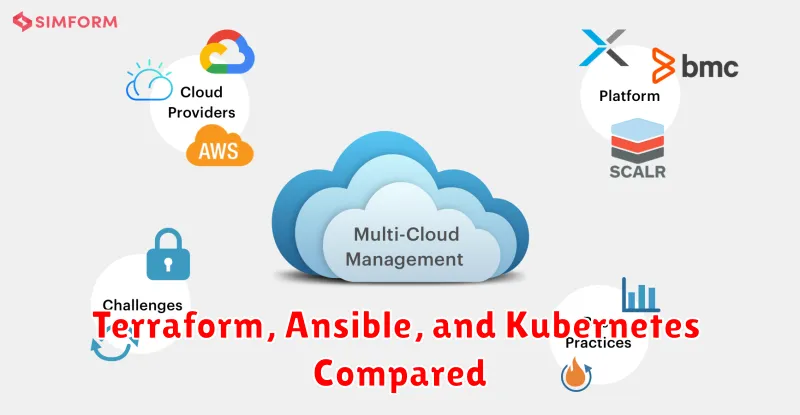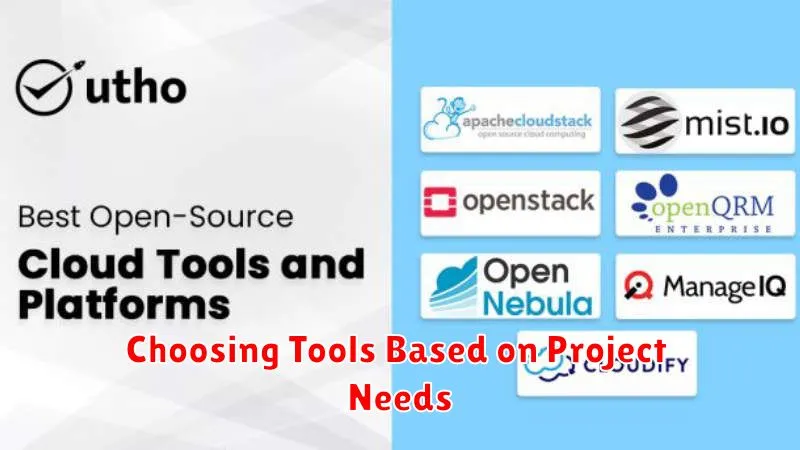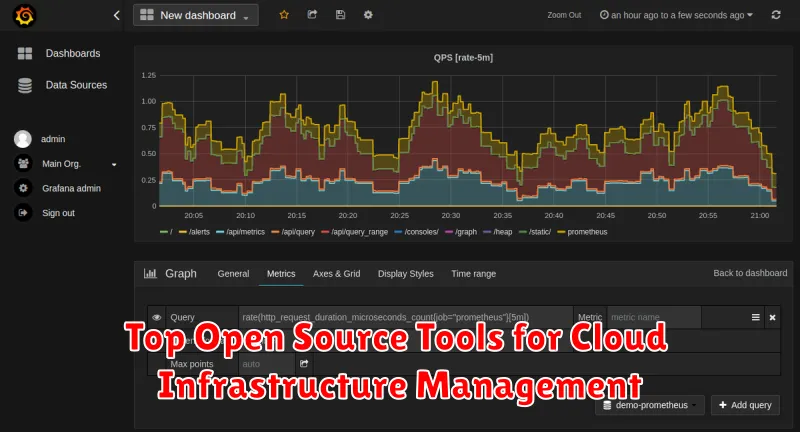Managing cloud infrastructure efficiently is crucial for any organization leveraging the power of the cloud. Cloud infrastructure management encompasses a wide range of tasks, from provisioning and orchestration to monitoring and security. Choosing the right tools is paramount to success in this complex landscape. Fortunately, the open-source community provides a wealth of robust and flexible tools for cloud infrastructure management, offering cost-effective alternatives to proprietary solutions. This article explores the top open-source tools available, empowering you to optimize your cloud infrastructure and streamline your operations.
Whether you’re working with AWS, Azure, Google Cloud, or a multi-cloud environment, leveraging open-source tools can significantly benefit your cloud infrastructure management strategy. These tools offer greater control, flexibility, and cost savings compared to proprietary options. From infrastructure automation and container orchestration to monitoring and security, open-source tools provide comprehensive solutions for all your cloud management needs. This article will delve into the leading open-source tools, highlighting their key features and benefits, enabling you to make informed decisions for your cloud infrastructure.
Why Use Open Source for Cloud?
Leveraging open-source software for cloud infrastructure offers significant advantages. A primary benefit is cost reduction. Open-source tools often eliminate licensing fees associated with proprietary software, allowing organizations to allocate resources more effectively.
Flexibility and customizability are also key drivers. Open-source code can be modified and tailored to specific needs, offering greater control over the cloud environment compared to closed-source alternatives. This empowers organizations to build bespoke solutions and integrate seamlessly with existing systems.
Community support plays a crucial role in the open-source ecosystem. A vast network of developers and users contribute to project development, documentation, and troubleshooting. This collaborative environment fosters rapid innovation and ensures access to a wealth of expertise.
Furthermore, open-source solutions often prioritize security through transparency. The open nature of the code allows for community scrutiny, identifying and addressing vulnerabilities more effectively. This collective approach strengthens security posture and builds trust.
Finally, open source promotes vendor independence. Organizations avoid lock-in to specific proprietary platforms, empowering them to choose the best solutions for their evolving cloud needs and fostering a more competitive landscape.
Best Tools for Automation and Monitoring
Effective cloud infrastructure management relies heavily on automation and monitoring. Several open-source tools excel in these areas, providing robust capabilities for streamlining operations and ensuring optimal performance.
For automation, Ansible is a popular choice. Its agentless architecture simplifies deployment and configuration management. Another powerful option is Terraform, which allows for infrastructure as code, enabling repeatable and version-controlled infrastructure deployments across various cloud providers.
Regarding monitoring, Prometheus offers a comprehensive solution for collecting and analyzing metrics. Its flexible query language and alerting capabilities make it well-suited for complex environments. Grafana complements Prometheus by providing a visually appealing dashboarding interface for visualizing the collected data. Nagios is another valuable tool, specializing in infrastructure monitoring and alerting for potential issues.
Terraform, Ansible, and Kubernetes Compared

Terraform, Ansible, and Kubernetes are all powerful open-source tools for managing cloud infrastructure, but they serve different purposes. Terraform focuses on provisioning and managing the underlying infrastructure itself, such as virtual machines, networks, and storage. It uses declarative configuration, meaning you define the desired end state, and Terraform figures out how to get there.
Ansible, on the other hand, excels at configuration management and application deployment. It uses imperative automation, meaning you define the steps to take, and Ansible executes them. While it can provision infrastructure, its strength lies in managing the software and settings within that infrastructure.
Kubernetes focuses on container orchestration, managing the deployment, scaling, and networking of containerized applications. It works on top of existing infrastructure and relies on tools like Terraform or Ansible for initial provisioning. Kubernetes automates the deployment and management of applications packaged in containers.
CI/CD Tools for Cloud Apps
Continuous Integration and Continuous Delivery (CI/CD) are crucial for rapidly deploying and updating cloud applications. Several open-source tools excel in this domain, offering robust automation and integration with cloud platforms.
Jenkins is a highly popular choice, providing extensive plugin support for various cloud providers and build tools. Its flexibility makes it adaptable to diverse project needs and scales well for complex deployments.
Spinnaker, specifically designed for cloud-native environments, handles sophisticated deployments across multiple cloud targets. Its focus on application management and immutable infrastructure simplifies release processes and reduces risk.
Drone offers a container-native approach to CI/CD, leveraging Docker for build and deployment pipelines. Its simplicity and scalability make it an attractive option for containerized applications.
Concourse CI, with its declarative pipeline configuration and focus on resource management, ensures reproducible builds and deployments. Its emphasis on immutability and versioning contributes to predictable and reliable outcomes.
Selecting the right CI/CD tool depends on specific project requirements, including the chosen cloud platform, application architecture, and team expertise. Careful evaluation of these factors is essential for successful CI/CD implementation.
Security and Compliance Tools
Maintaining a secure and compliant cloud infrastructure is crucial. Open-source tools offer robust capabilities for achieving this.
Open Policy Agent (OPA) provides a powerful policy engine for enforcing rules across your cloud environment. It allows you to define policies as code and integrates with various cloud platforms.
Chef InSpec is an open-source auditing and compliance framework. It automates the process of checking your infrastructure against compliance requirements, saving time and reducing manual effort.
Trivy is a vulnerability scanner that identifies security flaws in container images, file systems, and Git repositories. Its comprehensive scanning helps proactively address potential risks.
Community Support and Documentation
Community support is a crucial aspect when choosing open-source tools. A vibrant community provides valuable resources such as forums, mailing lists, and online communities where users can seek assistance, troubleshoot issues, and share best practices. Active communities ensure that challenges are addressed quickly and efficiently, contributing to a positive user experience.
Comprehensive documentation is essential for effectively utilizing open-source tools. Clear and concise documentation should cover installation, configuration, usage, and troubleshooting. Well-maintained documentation accelerates the learning process and empowers users to leverage the tool’s full capabilities. Look for projects with actively maintained documentation, including tutorials, FAQs, and API references.
Choosing Tools Based on Project Needs

Selecting the right open-source tools for cloud infrastructure management is crucial for project success. The decision should be driven by specific project requirements and organizational needs. Key factors to consider include the size and complexity of the infrastructure, the specific cloud provider being used (AWS, Azure, GCP, etc.), and the level of automation desired.
For example, a small project with basic infrastructure needs might benefit from simpler tools focused on configuration management, like Ansible or Chef. Larger, more complex deployments might necessitate tools designed for orchestration and container management, such as Kubernetes or Terraform. Cost considerations are also important. While the tools themselves are open source, factors like training, implementation, and ongoing maintenance can incur expenses.
Security requirements should also inform tool selection. Certain tools offer enhanced security features or integrations with existing security systems. Finally, consider the existing skillset of your team. Choosing tools that align with existing expertise can reduce the learning curve and accelerate implementation.

